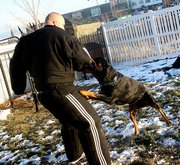 How To Fix Dogs That Fight In The Home
How To Fix Dogs That Fight In The Home
The following question comes in from a reader of our site-
Hello Ty,
I have the same question as Brenda did on thatmutt.com. (I wrote this message there a few days ago, also.) How about if its aggression towards another dog within the household? Same method? Or what can i do? I have 3 dogs (littermates) – I will call them Dog #1, #2 and #3 to differentiate them.
We got Dog #1 at 7 weeks of age, Dog #2 at 9 months, Dog #3 at almost 11 months old. Dog #2 and Dog #3 were owned by a person who then decided they didn’t have time for them (first Dog #2, then Dog #3). Those 2 dogs did fight at times and I don’t know the exact conditions they lived in. Dog #1 was neutered at 6 months old, we had Dog #2 and Dog #3 neutered as soon as we got them. Dog #1 gets along fine with both Dog #2 and Dog #3. However, Dog #2 and Dog #3 do not. Dog #2 attacks Dog #3 for no reason (we don’t have them all together now – we alternate keeping either Dog #2 or Dog #3 in a separate room with a gate in the doorway).
We bring Dog #2 on his harness and leash multiple times per day and there are times he can lay quite close to Dog #3 with no problem but you can see/feel him wanting to attack him again. From the time we had them all loose together in the house, we know that Dog #3 does not want to fight but will if he has to. (One time the attack happened under the kitchen table and it took me a little longer to be able to get at Dog #2 enough to pull him off of Dog #3.) I do not want to/will not re-home any of these dogs. I want to do the right thing to get them to get along or if not get along, at least tolerate one another so they can live together.
I never bring them outside together because we have a large fenced in yard and a fight could break out too far of a distance from me. I realize I am lucky that I have not gotten bit when I have pulled Dog #2 off of Dog #3. It just makes no sense – when we did have them all together, they could pass one another in the doorway 9-10 times, then in a split second, the 11th time, Dog #2 would instantaneously attack Dog #3 – no advance warning whatsoever. They will all be a year old at the end of this month (Dec 2012). I have spent countless hours researching on internet for ideas but don’t want to try the wrong thing. I found Ty Brown (you!) and have seen some of his videos and they seem so down to earth and sensible. Any help would be appreciated so very, very much.
The following is my response:
Watch How To Fix Dogs That Are Fighting In The Same House On Youtube
Dogs That Fight In The Home- Key Points
- It all starts with obedience training. Obedience equals calm and respectful. As I always say, you aren’t going to fix aggression with basic obedience. You need advanced obedience.
- Work on focused walks together. You should work towards one dog on one side of your body and the other dog on the other side. Both should be right by your side, no walking ahead, and paying attention to you.
- You need processes for around the house. Lots of ‘down stays’, waiting at the door, rules, discipline, etc.
- Control aspects of their life: doorways, toys, food, etc.
- More than likely you’ll want to start with dogs on leashes and training collars for a while. No harnesses.
- Best of luck!
For dogs with this level of aggression we recommend our curing dog aggression program.



Follow Us!